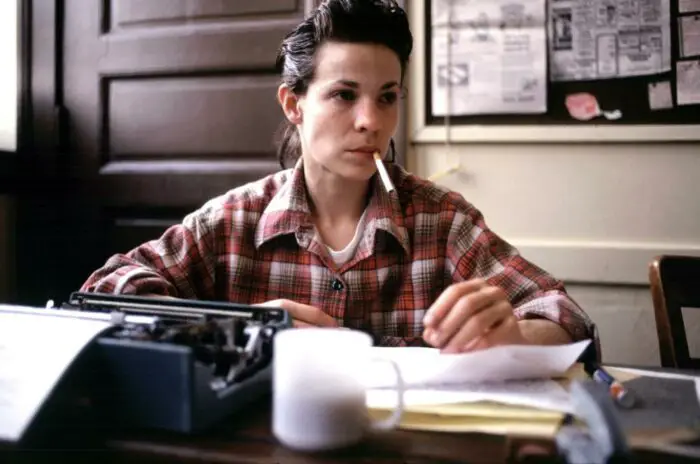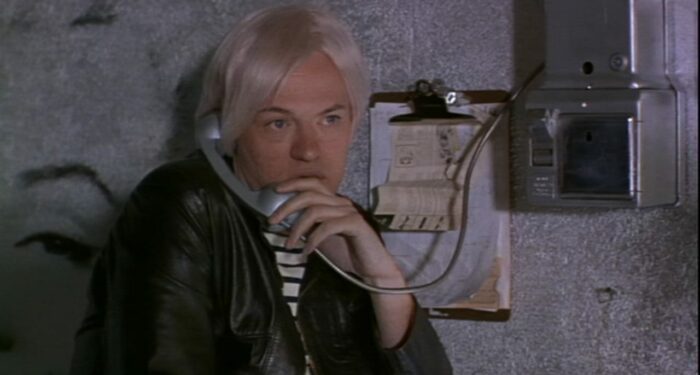I don’t know why my dad had this DVD. He doesn’t have much of a collection, and everything else in it feels plausible to him. Gladiator, The Abyss—mostly films that feel grand in scale or level of special effects. When I was 13, I was browsing the shelf one night and saw the cover of I Shot Andy Warhol and was immediately intrigued. I knew vaguely about the man and his Campbell soup art. Was this a parody? Some sort of John Malcovich situation? Surely this didn’t actually happen. Well, after a few watches, and some internet sleuthing, I had a bit of an inkling about this film that turns 25 this year.
This is the feature film debut of Mary Harron, who would later go on to direct American Psycho, which she also co-wrote. It also features a score by John Cale of The Velvet Underground. It stars Lili Taylor and Jared Harris as Valerie Solanas and Andy Warhol, respectively, two actors who would go on to become quite a bit more famous. It’s interesting looking back, as younger me had absolutely no idea who any of these people were, and now understanding what accomplished people they all are. (Particularly Jared Harris in The Terror and Chernobyl.)
It’s impossible to talk about the film without the real people involved in these events. Andy Warhol, who of course many people know as the king of Pop Art, with vivid, silkscreened portraits of celebrities and pieces like the famous Campbell’s Soup Cans that touches on commercialism. The poster for I Shot Andy Warhol is based on one of these, a piece fittingly titled Triple Elvis, with Valerie Solanas in the place of Presley. Years later I would see one of these prints in person by chance.
Valerie Solanas was a writer with a background in psychology. She had an incredibly terrible upbringing, regularly abused by her father, a troubled relationship with her mother and stepfather. She eventually ran away from home. Solanas came out as a lesbian in the 1950s, and I cannot imagine how difficult this would have been; it’s hard enough to come out these days, let alone back then. She worked at an animal research center before eventually moving to New York City, where the events of this story would take place.

The film follows Solanas during her life in New York, homeless and sometimes working as a prostitute to make ends meet. Several months later she gets introduced to Warhol through a friend-of-a-friend. She’s been writing a screenplay and wants Warhol to produce it. At the same time, she signs a deal with a publisher to write a pornographic novel. Working on both of these she also becomes more involved in Warhol’s life, including appearing in one of his films at The Factory.
Warhol’s art studio, known as The Factory, was a regular hangout for a variety of artists, performers, and other personalities. Sometimes they would be featured in Warhol’s films and became known as Warhol Superstars. They also helped him mass-produce his paintings to help fund The Factory, and probably, most likely, did a lot of drugs. It was the 60s; many of the superstars were queer, including drag queens and transgender socialites. The concept of free love was steadily becoming a thing during these times, in contrast to the conservative views of the 50s and earlier. Queer people have always existed, but now it was becoming more visible.
As someone coming to terms with their sexuality (at the time a forced-to-come-out lesbian, now non-binary) I took an instant liking to the people and fashions surrounding Andy Warhol’s Factory. I had never seen people portrayed as so obviously queer on screen before, and I drank it up like a dying man in a desert. My identity was always something to hide away, to be ashamed of, but here were people creating ART and embracing being true to themselves. I grew up in a very small town and often felt like the only gay person. New York City seemed like the opposite, full of all sorts of people! Solanas herself was unabashedly gay. She felt everything fully, expressing herself and her views including the infamous SCUM Manifesto she penned. Intercut between scenes are black-and-white shots of Solanas speaking to the camera directly and reading from the manifesto.
To keep it short, the SCUM Manifesto was a critique of patriarchy by Solanas to (in my opinion) vent her anger at how she was treated, how she grew up, and how she saw the world. The opening line sums it up nicely:
“Life” in this “society” being, at best, an utter bore and no aspect of “society” being at all relevant to women, there remains to civic-minded, responsible, thrill-seeking females only to overthrow the government, eliminate the money system, institute complete automation and eliminate the male sex.
Some viewed this as a parody, but Solanas insisted she was serious. To grow up abused by men and not come out a bit wary is impossible. Women and femmes all grow up with warnings ingrained into us: don’t talk to people like this, carry pepper spray, etc. To add to this Solanas seemed to be dealing with an undiagnosed mental illness, which I related to quite a lot. I’m not condoning what she did at all; it was terrible. I’m just saying I understand how it feels to be upset, lost, and angry with such intensity. The way we deal with that pain is always different.
But, and here’s the but, it’s flawed. Just like the woman who committed this crime is flawed, her views on gender and anger towards men (however justified) are flawed. 13 year old me didn’t understand this. At that age I barely understood anything. I just knew the hurt when people threw slurs or drinks in my direction, and it felt good to see someone angry. I knew Andy Warhol was a real person, but I thought this story, this movie, was made up. Wikipedia wasn’t really a big thing yet when I was a teen so just looking it up wasn’t as easy as it is now.
In the film, Warhol keeps putting off dealing with Solanas’ screenplay. He said he would help her with it, but seems to regret saying this. He eventually misplaces it which enrages her. She starts to think Warhol and her publisher are working together to control her. She also realizes the contract she signed with the publisher gives him much more control over her work. After going on a rage complaining about these things, she’s kicked out of The Factory. Already a very tetchy person, Solanas starts to crack. Later she agrees to appear on a talk show, and having hoped to have used it as a platform to speak about feminism, angrily storms off stage when the host seems to have no interest in talking to her besides making fun of her butch appearance. It’s at this point that Solanas buys a gun.
Solanas believed Warhol stole her screenplay, and whether that’s true or not, he obviously didn’t deserve to be shot. Nobody does. His personality is standoffish, and he always appears slightly bored with everything around him. I’m not sure how accurate this is to the actual man, but since it appears to be the standard across portrayals of him, parody or not, I’m inclined to think he would have been extremely annoying to know in person. It’s exactly the kind of personality that would clash with Solanas’ “in your face”, New Jersey attitude. It’s unfortunate that it ended the way it did. Before the infamous shooting, Solanas puts on makeup. She apparently did this in real life too, which I find interesting. Warhol survived the attack, but as the bullet went through both lungs, his spleen, stomach, liver, and esophagus—it wasn’t pretty and left him with lifelong pain. Solanas turns herself in immediately: “I had to do it. He had too much control over my life”, she says.

While we do follow Solanas in the film, and she directly talks to us, the audience, it feels like we are meant to watch her downfall. She’s not a hero. It starts with her getting arrested, with the main chunk of the film taking place as a flashback. Interestingly, the film was originally supposed to be a documentary, but it was difficult to find footage of Solanas or anyone who wanted to speak about her. Solanas passed away in 1988, and I don’t think she would have wanted to participate anyway.
Costumes, sets, and music are all very fitting to the 60s. We have tons of photos of Warhol’s studio and the people who were there, so it must have been insanely helpful to have those as reference. Paintings were also recreated for the film and destroyed afterward. I’m sure they didn’t want “fakes” to stay around, considering Warhol’s art has sold for tens of millions.
What I take away, rewatching this as an adult with the myriad of experiences and comfortability of my identity now, is the pain that Solanas must have been going through, how things could have ended quite differently. Before I got on track with my health issues, I had a lot of anger inside of me and directed it in very poor ways. Could my life have gone differently? Could hers? It’s hard to say. It’s an interesting and stylish film looking back on a tragic event, in any case. Warhol is credited with the saying “In the future, everyone will be world-famous for 15 minutes”. Solanas certainly got that.


